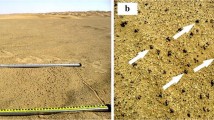Abstract
Blown sand has caused considerable damage to the Dunhuang Mogao Grottoes of China. Controlling the blown sand requires a clear understanding of the processes that govern its production and movement. Experiments were conducted in a wind tunnel and in the field to define the relationships between sand production and gravel coverage in the gobi above the Mogao Grottoes. The gravel that covers the gobi’s surface controls wind erosion, irrespective of its shape and size. The equilibrium coverage by gravel over which no further sand is emitted due to wind erosion increases and the equilibration time that is taken to form the equilibrium gravel coverage decreases with increasing wind velocity. Gravel coverage has reached an equilibrium state in the portion of the gobi directly above the grottoes, but decreases towards the Mingsha Mountains. Drifting sand from these mountains is the main source of sand damage at the Mogao Grottoes. If no additional sand from the mountains were supplied to the gobi, gravel pavements would reach an equilibrium level of coverage and prevent further production of blowing sand. Sand blown from the gobi represents secondary reactivation of sediments originally produced in the Mingsha Mountains. Therefore, to control the blowing sand above the Mogao Grottoes, emphasis should be placed on controlling erosion from the Mingsha Mountains rather than local erosion of sand in the gobi.








Similar content being viewed by others
References
Agnew N, Lin PM, Li ZX, Wang XD (1999) A lightweight composite panel for repair of cave roofs at the Mogao Grottoes, China. Conserv Manage Archaeol Sites 3(3):135–144
Dong Z, Liu X, Wang X (2002) Aerodynamic roughness of gravel beds. Geomorphology 43(1–2):17–31
Fan JS (2003) Building Dunhuang Academy into a world-class antiquities museum. Social Sci China 63(1):169–178
Gillette DA, Stockton PH (1989) The effect of nonerodible particles on wind erosion of erodible surfaces. J Geophys Res 94(D10):12: 885–12: 893
Jin A (1986) The Dunhuang Mogao Grottoes are faced with danger which be buried by the shifting sand (in Chinese). Cult Work 5:18
Li ZX, Agnew N, Lin PM (1993) Chemical consolidation of conglomerate and sand at the Mogao Grottoes. In: Agnew N, Li ZX (eds) Conservation of ancient sites on the silk road, the second international conference on the conservation of Grotto Sites, Dunhuang, pp 194–212
Lin YQ, Qu JJ, Fan JS, Li YH (1993) Research into the control of damage by windblown sand at the Mogao Grottoes. In: Conservation of ancient sites on the silk road, the second international conference on the conservation of Grotto Sites, Dunhuang, pp 213–226
Liu LY, Liu YZ, Li XY, Wang JH, Peng HM (1999) Effect of gravel mulch restraining soil deflation by wind tunnel simulation (in Chinese, with English abstract). J Desert Res 19(1):60–62
McKenna NC (1998) Particle transport and adjustment of the boundary layer over rough surfaces with an unrestricted, upwind supply of sediment. Geomorphology 25:1–17
Qu JJ, Huang N, Dong GR, Zhang WM (2001) The role and significance of the Gobi Desert pavement in controlling sand movement on the cliff top near the Dunhuang Mogao Grottoes. J Arid Environ 48(3):357–371
Wang JY (1990) Could the Mogao Grottoes be buried by the shifting sand? (in Chinese). The Nature 2:30–31
Wang T, Zhang WM, Wang WF, Qu JJ (2004a) The study on the functions of arresting and transporting sands of the gobi preventing system over the top of the Mogao Grottoes (in Chinese, with English abstract). J Desert Res 24(2):187–190
Wang WF, Wang T, Li ZX, Zhang WM (2004b) The effects of blown sand on the shrub belt over the top of the Mogao Grottoes (in Chinese, with English abstract). Acta Ecologica Sinica 24(1):2492–2500
Wang WF, Wang T, Zhang WM, Li ZX, Wang XD, Zhang GB, Agnew N, Lin PM (2004c) A study of the effectiveness of integral control of wind-blown sand at Mogao Grottoes. In: Agnew N, Li ZX (eds) Conservation of ancient sites on the silk road, the second international conference on the conservation of Grotto Sites, Dunhuang, p 47
Willetts BB, Rice MA (1988) Particle dislodgment from flat sand bed by wind. Earth Surf Process Landforms 13:717–728
Xue X, Zhang WM, Wang T (2000) Wind tunnel experiments on the effects of gravel protection and problems of field surveys. Acta Geographica Sinica 5(3):375–383
Zhang WM, Wang T, Wang WF (2004) The gobi sand stream and its control over the top surface of the Mogao Grottoes, China. Bull Eng Geol Environ 63(3):261–269
Zhu ZD (1999) Desert, desertification and its control and strategies. Chinese Environmental Science Press, Beijing
Acknowledgments
The authors gratefully acknowledge the funding from the Knowledge Innovation Project of the Chinese Academy of Sciences through Grant KZCX3-SW−341, and the Dunhuang-Hong Kong Buddhist Meritorious Service Plan.
Author information
Authors and Affiliations
Corresponding author
Rights and permissions
About this article
Cite this article
Wang, W., Dong, Z., Wang, T. et al. The equilibrium gravel coverage of the deflated gobi above the Mogao Grottoes of Dunhuang, China. Environ Geol 50, 1077–1083 (2006). https://doi.org/10.1007/s00254-006-0281-6
Received:
Accepted:
Published:
Issue Date:
DOI: https://doi.org/10.1007/s00254-006-0281-6



